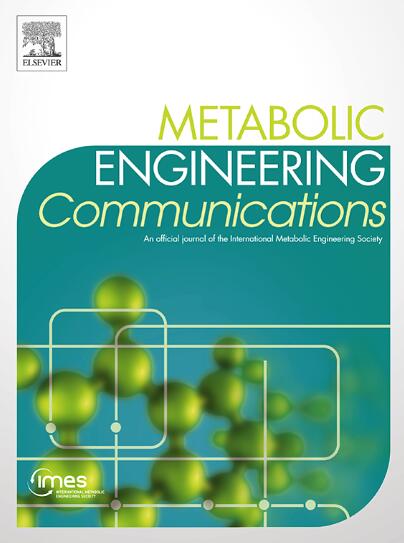13C-metabolic flux analysis of Saccharomyces cerevisiae in complex media
IF 4.1
Q2 BIOTECHNOLOGY & APPLIED MICROBIOLOGY
引用次数: 0
Abstract
Saccharomyces cerevisiae is often cultivated in complex media for applications in food and other biochemical production. However, 13C-metabolic flux analysis (13C-MFA) has been conducted for S. cerevisiae cultivated in synthetic media, resulting in a limited understanding of the metabolic flux distributions under the complex media. In this study, 13C-MFA was applied to S. cerevisiae cultivated in complex media to quantify the metabolic fluxes in the central metabolic network. S. cerevisiae was cultivated in a synthetic dextrose (SD) medium supplemented with 20 amino acids (SD + AA) and yeast extract peptone dextrose (YPD) medium. The results revealed that glutamic acid, glutamine, aspartic acid, and asparagine are incorporated into the TCA cycle as carbon sources in parallel with glucose consumption. Based on these findings, we successfully conducted 13C-MFA of S. cerevisiae cultivated in SD + AA and YPD media using parallel labeling and measured amino acid uptake rates. Furthermore, we applied the developed approach to 13C-MFA of yeast cultivated in malt extract medium. The analysis revealed that the metabolic flux through the anaplerotic and oxidative pentose phosphate pathways was lower in complex media than in synthetic media. Owing to the reduced carbon loss by the branching pathways, carbon flow toward ethanol production via glycolysis could be elevated. 13C-MFA of S. cerevisiae cultured in complex media provides valuable insights for metabolic engineering and process optimization in industrial yeast fermentation.
酵母在复杂培养基中的13c代谢通量分析
酿酒酵母通常在复杂的培养基中培养,用于食品和其他生化生产。然而,对酿酒酵母在合成培养基中培养的13c -代谢通量分析(13C-MFA),对复杂培养基下的代谢通量分布了解有限。本研究将13C-MFA应用于复杂培养基培养的酿酒酵母,量化其中心代谢网络中的代谢通量。在添加20种氨基酸(SD + AA)和酵母提取液蛋白胨葡萄糖(YPD)的合成葡萄糖(SD)培养基中培养酿酒酵母。结果表明,谷氨酸、谷氨酰胺、天冬氨酸和天冬酰胺作为碳源被纳入TCA循环,与葡萄糖消耗平行。基于这些发现,我们成功地利用平行标记法对SD + AA和YPD培养基培养的酿酒酵母进行了13C-MFA分析,并测量了氨基酸摄取率。此外,我们将该方法应用于麦芽提取物培养基中培养的酵母13C-MFA。分析结果表明,复合培养基中戊糖磷酸脱色和氧化途径的代谢通量低于合成培养基。由于分支途径减少了碳损失,通过糖酵解向乙醇生产的碳流量可能会增加。复杂培养基培养的酿酒酵母13C-MFA为工业酵母发酵代谢工程和工艺优化提供了有价值的见解。
本文章由计算机程序翻译,如有差异,请以英文原文为准。
求助全文
约1分钟内获得全文
求助全文
来源期刊

Metabolic Engineering Communications
Medicine-Endocrinology, Diabetes and Metabolism
CiteScore
13.30
自引率
1.90%
发文量
22
审稿时长
18 weeks
期刊介绍:
Metabolic Engineering Communications, a companion title to Metabolic Engineering (MBE), is devoted to publishing original research in the areas of metabolic engineering, synthetic biology, computational biology and systems biology for problems related to metabolism and the engineering of metabolism for the production of fuels, chemicals, and pharmaceuticals. The journal will carry articles on the design, construction, and analysis of biological systems ranging from pathway components to biological complexes and genomes (including genomic, analytical and bioinformatics methods) in suitable host cells to allow them to produce novel compounds of industrial and medical interest. Demonstrations of regulatory designs and synthetic circuits that alter the performance of biochemical pathways and cellular processes will also be presented. Metabolic Engineering Communications complements MBE by publishing articles that are either shorter than those published in the full journal, or which describe key elements of larger metabolic engineering efforts.
 求助内容:
求助内容: 应助结果提醒方式:
应助结果提醒方式:


